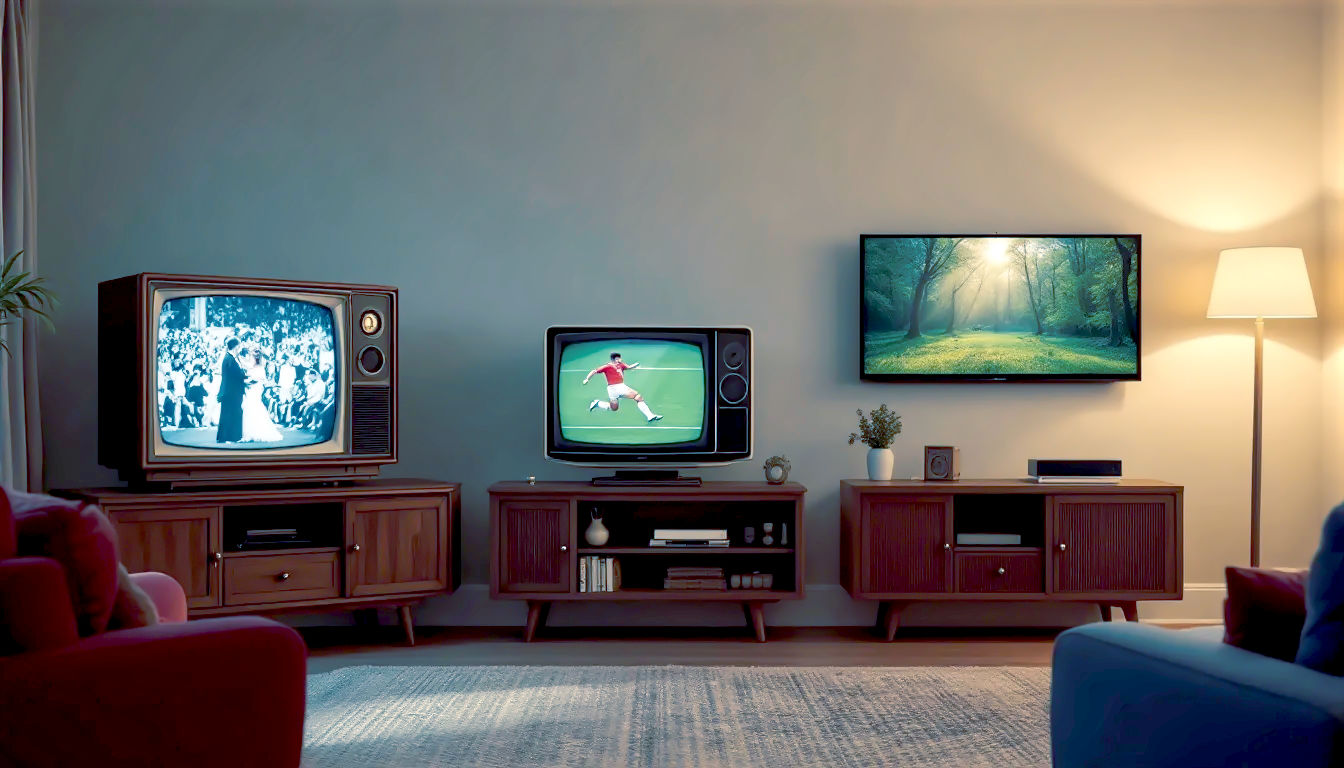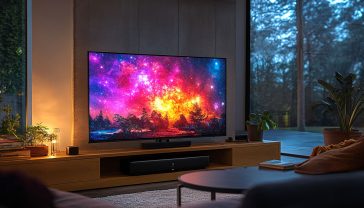From Flickering Boxes to Glowing Walls: The Epic Story of The Television
Explore the incredible journey of the television, from John Logie Baird’s first flickering images to the battle between OLED and QLED and the rise of the smart TV.

This post may contain affiliate links. If you make a purchase through these links, we may earn a commission at no additional cost to you.
It’s almost impossible to imagine a world without television. From Saturday night telly with the family to binge-watching a new series on a rainy Sunday, it has been the glowing heart of British living rooms for generations. We’ve gathered around it for coronations, World Cup finals, moon landings, and dramatic soap opera showdowns. But have you ever stopped to wonder how this magic box actually came to be?
The journey from the first flickering, blurry images to the pin-sharp, wall-sized screens we have today is an incredible story of genius inventors, fierce rivalries, and mind-boggling technology. It’s a tale that whisks us from a dusty London workshop to gleaming laboratories in Japan, and it’s packed with more twists and turns than an episode of Line of Duty.
So, grab a cuppa, get comfy on the sofa, and let’s rewind. We’re about to explore the complete history of the telly, from the hefty, buzzing boxes of our grandparents’ day to the ultra-thin screens that are smarter than the computers that sent us to the moon.
The big idea: How do you send pictures through the air?
Before we can even talk about a ‘television set’, we need to understand the ridiculously clever idea behind it. How on earth can you capture a moving picture, turn it into an invisible signal, send it flying through the air, and then magically put it back together on a screen miles away?
It all boils down to two key things: scanning and light.
Imagine you’re reading this article. Your eyes don’t take in the whole page at once. They move, or scan, from left to right, line by line. Television works in a similar way. A camera ‘scans’ an image, breaking it down into tiny little dots, or pixels. It does this incredibly fast, scanning hundreds of lines in the blink of an eye.
For each dot, it measures how bright it is. Is it bright white? Dark black? Or a shade of grey in between? This information is then converted into an electrical signal. Brighter dots get a stronger signal, darker dots a weaker one. This signal is then broadcast through the air as a radio wave.
Back in your living room, your TV aerial picks up this signal. The telly then does the whole process in reverse. It shoots a beam of electrons (tiny particles) at a screen. A strong signal makes the beam stronger, which makes a dot on the screen glow brightly. A weak signal makes a dot glow dimly. By recreating the pattern of dots line by line, at lightning speed, your TV rebuilds the original picture. And because it does this 25 times every second (in the UK system), your brain is tricked into seeing a smooth, moving image. Simple, right? Well, not for the people who had to invent it.
The pioneers: Mechanical monsters and a Scottish genius
Long before the electronic telly we know, the first attempts were, frankly, a bit bonkers. They were mechanical televisions, clunky contraptions that used spinning discs, motors, and mirrors.
The spinning disc that started it all
The key invention was a thing called the Nipkow disc, dreamed up by a German student named Paul Nipkow way back in 1884. It was a simple metal disc with holes punched in it in a spiral pattern. As the disc spun, each hole would scan one line of an image. It was a brilliant idea, but the technology to make it work properly just wasn’t there yet.
John Logie Baird: The determined Scot
Fast forward to the 1920s, and a determined, often penniless, Scottish inventor named John Logie Baird enters the scene. Working in a small attic workshop in London, Baird became obsessed with making mechanical television work. His first contraptions were famously cobbled together from whatever he could find, including a tea chest, biscuit tins, and bicycle lamp lenses sealed with wax.
It sounds like something out of Wallace and Gromit, but it worked. In 1926, Baird gave the world’s first public demonstration of a working television system to members of the Royal Institution. The images were tiny, flickering, and orange-brown, showing the head of a ventriloquist’s dummy nicknamed ‘Stooky Bill’. It wasn’t exactly high definition, but it was a monumental breakthrough. A machine could now transmit a moving image from one room to another.
The BBC was intrigued. They gave Baird the chance to start experimental broadcasts, and in 1929, the first television programmes were aired from their London studio. For the handful of people with a Baird ‘Televisor’, it must have felt like witnessing pure witchcraft.
The electric dream: The battle for the future of TV
Baird’s mechanical system was amazing, but it had its limits. The spinning discs were noisy, the pictures were low-resolution (only 30 lines, compared to over 1,000 on a modern 4K TV), and the whole thing was prone to breaking down. A better idea was already on the horizon: electronic television.
The magic of the cathode ray tube
The heart of this new system was the cathode ray tube (CRT). This sounds complicated, but the idea is quite neat.
- Simplified Explanation: Think of a CRT as a sealed glass bottle, wide at the front (the screen) and narrow at the back. At the back is an ‘electron gun’. This gun fires a beam of electrons, like a tiny water pistol, towards the screen. The inside of the screen is coated with special chemicals called phosphors, which glow when the electrons hit them. By using magnets to steer this electron beam very precisely and quickly across the screen, you can draw a picture, line by line.
- Detailed Explanation: The electron gun at the rear of the vacuum-sealed tube heats a cathode, causing it to release a stream of electrons. These electrons are focused into a tight beam and accelerated towards the screen by a high-voltage anode. Two pairs of electromagnetic coils, known as a deflection yoke, are placed around the neck of the tube. One pair controls the horizontal movement of the beam, and the other controls the vertical movement. The incoming video signal modulates the intensity of the electron beam—a stronger signal means more electrons, creating a brighter dot (pixel) on the phosphorescent screen. By sweeping the beam horizontally across the screen while simultaneously moving it down line by line, a complete picture or ‘frame’ is created.
This electronic system had huge advantages. It was completely silent, had no moving parts to wear out, and, most importantly, it could produce much sharper, brighter, and more detailed pictures.
A very British showdown
By the mid-1930s, a fierce battle was brewing. Who would control the future of television? In one corner, you had John Logie Baird and his improved mechanical system. In the other, a powerful new company called Marconi-EMI, which had developed a cutting-edge all-electronic system.
In 1936, the BBC decided to settle it once and for all. They started the world’s first regular high-definition television service from Alexandra Palace in London, broadcasting both systems on alternate weeks. For a few months, viewers could watch a Baird programme one night and a Marconi-EMI one the next.
It quickly became clear that the electronic system was far superior. The pictures were clearer and more stable. In early 1937, the BBC dropped the Baird system for good. It was a tough blow for the Scottish pioneer, but the age of electronic television had truly begun. Those early CRT sets were huge, heavy pieces of furniture with tiny screens, but for the few thousand households that owned one, they were a window to a new world.
Colour comes to the nation: Painting the world in technicolour
The first televisions were all in black and white. Bringing colour to the screen was the next great challenge, and it was a lot trickier than it sounds.
The problem was backwards compatibility. Any new colour system had to work with the existing black-and-white sets. You couldn’t just switch off the old service and tell millions of people their expensive tellies were now useless. The colour signal had to cleverly piggyback on top of the old black-and-white one.
The three-way fight: PAL, NTSC, and SECAM
In the 1950s and 60s, engineers around the world developed three main competing systems for broadcasting colour television.
- NTSC (National Television System Committee): The first system, developed in the USA. It got colour on air quickly, but it had a flaw. The colours could sometimes shift, leading engineers to joke that NTSC stood for “Never The Same Colour”.
- SECAM (Séquentiel Couleur à Mémoire): A French system designed to fix the colour-shifting problem of NTSC. It was robust but technically more complex.
- PAL (Phase Alternating Line): A German-developed system that was a clever improvement on NTSC. It ingeniously corrected for colour errors on every other line, resulting in a much more stable and accurate picture.
After much debate, the UK chose the PAL system. It was technically superior and gave fantastic, reliable colour. The BBC launched its first regular colour broadcasts in July 1967 on BBC Two, just in time for the Wimbledon tennis championships. Can you imagine the thrill of seeing that perfect green lawn in colour for the first time? By the end of the decade, both BBC One and ITV had also made the switch, and the black-and-white era began to fade.
Colour CRT tellies were complex beasts. Inside, they had three electron guns—one for red, one for green, and one for blue. The screen was coated with tiny phosphor dots or stripes of the same three colours. A special plate with tiny holes, called a shadow mask, was placed just behind the screen to make sure the red gun only hit red phosphors, the green gun only hit green, and so on. By mixing the brightness of these three primary colours at each point on the screen, the TV could create a full spectrum of millions of different hues.
The revolution of the flat screen: Getting rid of the big box
For fifty years, the cathode ray tube was king. But it had one massive drawback: its size. Because the electron gun had to be a certain distance from the screen to be able to scan the whole picture, CRT televisions were incredibly deep and heavy. A 32-inch CRT TV could weigh as much as an adult and take up half the living room. Everyone dreamed of a telly that was thin enough to hang on the wall like a picture.
In the late 1990s and early 2000s, that dream finally started to come true, thanks to two new technologies: Plasma and LCD.
Plasma: The glowing gas screens
Plasma screens were the first commercially successful flat-panel TVs. They offered big screen sizes and fantastic picture quality.
- Simplified Explanation: Imagine a plasma screen as a giant grid of tiny, fluorescent light bulbs. Each bulb, or cell, is filled with a special gas. When you apply electricity to a cell, the gas turns into a plasma and emits invisible ultraviolet (UV) light. This UV light then hits a phosphor coating on the inside of the cell, causing it to glow red, green, or blue. By controlling which cells are switched on and how brightly they glow, you can create a picture.
- Detailed Explanation: Each pixel in a plasma display panel (PDP) is made up of three sub-pixel cells containing a mixture of inert gases like neon and xenon. When a voltage is applied between two electrodes within a cell, the gas is ionised, creating a plasma discharge. This discharge excites the gas atoms, which then release energy as photons of UV light. The UV photons strike the phosphor material lining the cell walls, and the phosphors fluoresce, emitting visible light. Because each pixel generates its own light, plasma TVs could produce very deep, inky blacks (by simply switching the cell off) and had excellent contrast ratios and wide viewing angles.
Plasma TVs were brilliant. They had vibrant colours and were great for watching fast-moving sport because the pixels could switch on and off almost instantly, preventing motion blur. However, they were also expensive, heavy, power-hungry, and could suffer from “screen burn,” where a static image like a channel logo could become permanently etched onto the screen.
LCD: The liquid crystal breakthrough
At the same time as plasma was making a splash, another technology was quietly improving: LCD (Liquid Crystal Display). This is the technology that powers your laptop screen, your digital watch, and eventually, most of the world’s TVs.
- Simplified Explanation: An LCD TV screen is like a sandwich. The back layer is a big, bright light source, called a backlight. In front of that is a grid of millions of tiny little shutters, called liquid crystals. These crystals are special because they can twist and untwist when you apply electricity to them. When they are twisted, they let the light from the backlight pass through. When they are untwisted, they block the light. Each shutter has a red, green, or blue colour filter in front of it. By precisely controlling how much each tiny shutter opens or closes, the TV controls how much red, green, and blue light gets through to create the final pixel colour you see.
- Detailed Explanation: An LCD panel consists of a layer of liquid crystals sandwiched between two polarising filters. The backlight (initially cold-cathode fluorescent lamps or CCFLs) provides a constant source of illumination. Each pixel is divided into three sub-pixels, each with a red, green, or blue colour filter. A thin-film transistor (TFT) applies a voltage to each sub-pixel’s liquid crystals. When no voltage is applied, the crystals align in a way that twists the light passing through them, allowing it to pass through the second polariser. When a voltage is applied, the crystals straighten out, blocking the light. By varying the voltage, the amount of light passing through can be precisely controlled.
Early LCD TVs struggled to compete with plasma. Their blacks weren’t as deep (because the backlight was always on, some light would always leak through), and they had slower response times, which could cause blurring. But scientists and engineers worked relentlessly to improve them. The biggest leap forward was the switch from fluorescent CCFL backlights to smaller, more efficient LEDs (Light-Emitting Diodes). This allowed TVs to become much thinner, use less power, and gave engineers more control over the screen’s brightness.
This led to so-called “LED TVs,” which are still just LCD TVs, but with a better backlight. Techniques like local dimming were introduced, where the LEDs behind dark parts of the picture could be dimmed or switched off completely, dramatically improving the black levels and making LCDs a real challenger to plasma. In the end, LCD’s lower cost, lighter weight, and better energy efficiency won out. By the mid-2010s, plasma was effectively dead, and the LCD TV ruled the world.
The modern era: QLED vs OLED – The battle for perfection
Today, if you walk into a Currys or a John Lewis, the TV landscape is dominated by two main high-end technologies: QLED and OLED. They sound similar, but they work in fundamentally different ways.
QLED: Perfecting the LCD
QLED stands for Quantum Dot Light Emitting Diode. It might sound futuristic, but a QLED TV is essentially a very advanced version of the LED-backlit LCD TV we just talked about.
- Simplified Explanation: The “Quantum Dot” part is the clever bit. It’s an extra layer of microscopic, man-made crystals that sits between the LED backlight and the LCD panel. When the blue light from the LEDs hits these quantum dots, they glow with incredibly pure red and green light. This purer light source allows the TV to produce a much wider and more accurate range of colours than a standard LED TV. It’s like giving your telly a better box of crayons to work with, resulting in more vibrant and lifelike pictures.
- Detailed Explanation: In a QLED display, a blue LED backlight illuminates a quantum dot enhancement film (QDEF). The quantum dots are nanocrystals whose colour of emission is determined by their size. The QDEF contains dots tuned to emit very pure red and green light when excited by the blue backlight. This combination of pure red, green, and blue light (from the backlight passing through) creates a high-purity white light that then passes through the LCD and colour filter assembly. This process, known as photoluminescence, allows QLED TVs to achieve a significantly wider colour gamut (over 90% of the DCI-P3 colour space) and higher peak brightness levels compared to traditional LED-LCDs.
QLEDs are brilliant for bright rooms. They can go incredibly bright, making them perfect for watching TV during the day without the picture looking washed out.
OLED: The self-lighting pixels
OLED stands for Organic Light Emitting Diode. This technology is a true game-changer and is fundamentally different from everything that has come before. It’s the first time since plasma that we’ve had a mainstream technology where the pixels create their own light.
- Simplified Explanation: With an OLED TV, there is no backlight at all. Every single one of the millions of pixels on the screen is its own tiny, organic light source. It can be switched on or off completely independently. This is a massive deal. To show black, an OLED pixel just switches itself off. Completely. It emits no light whatsoever. This creates what’s called “perfect black”.
- Detailed Explanation: An OLED pixel is composed of a stack of thin organic material layers sandwiched between two electrodes. When a current is applied, electrons and “holes” are injected from the cathode and anode, respectively. They recombine in an emissive layer, releasing energy in the form of a photon of light. This process is called electroluminescence. By using different organic materials, red, green, and blue light can be produced. Because each pixel is a self-contained light source, no backlight is needed. This allows for perfect black levels, leading to an effectively infinite contrast ratio. It also means OLED TVs can be impossibly thin and even flexible, as they don’t need the bulky backlight and liquid crystal layers.
This ability to control light at the individual pixel level gives OLEDs an astonishing picture quality, especially in a darkened room. The contrast between the brightest brights and the darkest blacks is breathtaking. Films and high-end TV dramas look incredibly cinematic. They also have near-instantaneous response times and wider viewing angles than any LCD.
The downside? OLEDs can’t get as bright as the best QLEDs, and they carry a theoretical risk of screen burn, although modern TVs have many built-in features to prevent this.
Beyond the picture: The rise of the Smart TV
The story of the telly isn’t just about picture quality. It’s also about what we can watch on it. For decades, you were limited to a handful of broadcast channels. Then came satellite and cable, giving us hundreds. But the biggest shift of all has been the arrival of the internet.
The Smart TV has completely changed our relationship with the box in the corner. It’s no longer just a passive screen for receiving broadcasts; it’s an interactive entertainment hub. With built-in Wi-Fi and operating systems like Android TV, WebOS, or Tizen, a modern TV is essentially a giant tablet.
You can now access a universe of content on demand through apps like BBC iPlayer, Netflix, Disney+, and Amazon Prime Video. You can browse the web, play games, and even control your smart home devices from your sofa. This shift from linear, scheduled broadcasting to on-demand streaming is arguably the biggest change in our viewing habits since the invention of the remote control.
The future: What’s next for the humble telly?
The evolution of the television is far from over. Engineers are constantly pushing the boundaries of what’s possible.
- 8K Resolution: We’ve already moved from Standard Definition (SD) to High Definition (HD) and now 4K (Ultra HD). The next step is 8K, which packs in four times as many pixels as a 4K TV. While there’s very little 8K content available right now, it promises an almost holographic level of detail on very large screens.
- MicroLED: This is seen by many as the ultimate display technology. Like OLED, its pixels are self-emissive, but they use inorganic LEDs (like the ones in giant stadium screens) instead of organic materials. This means they can offer the perfect blacks of OLED but with the massive brightness of QLED, and with no risk of screen burn. It’s currently incredibly expensive, but it could be the king of TVs in a decade’s time.
- Transparent and Rollable TVs: We’re already seeing the first generation of TVs with flexible OLED screens that can roll up into a box when you’re not using them, or even screens that are see-through. In the future, your TV might just disappear into the furniture or become an invisible part of your window.
From Baird’s tea chest to a transparent screen you can see through, the television has come an unimaginably long way. It has shaped our culture, brought us together for moments of national celebration and sorrow, and entertained us for nearly a century. Whatever form it takes next, one thing is certain: we’ll still be gathering around its warm glow for many years to come.






